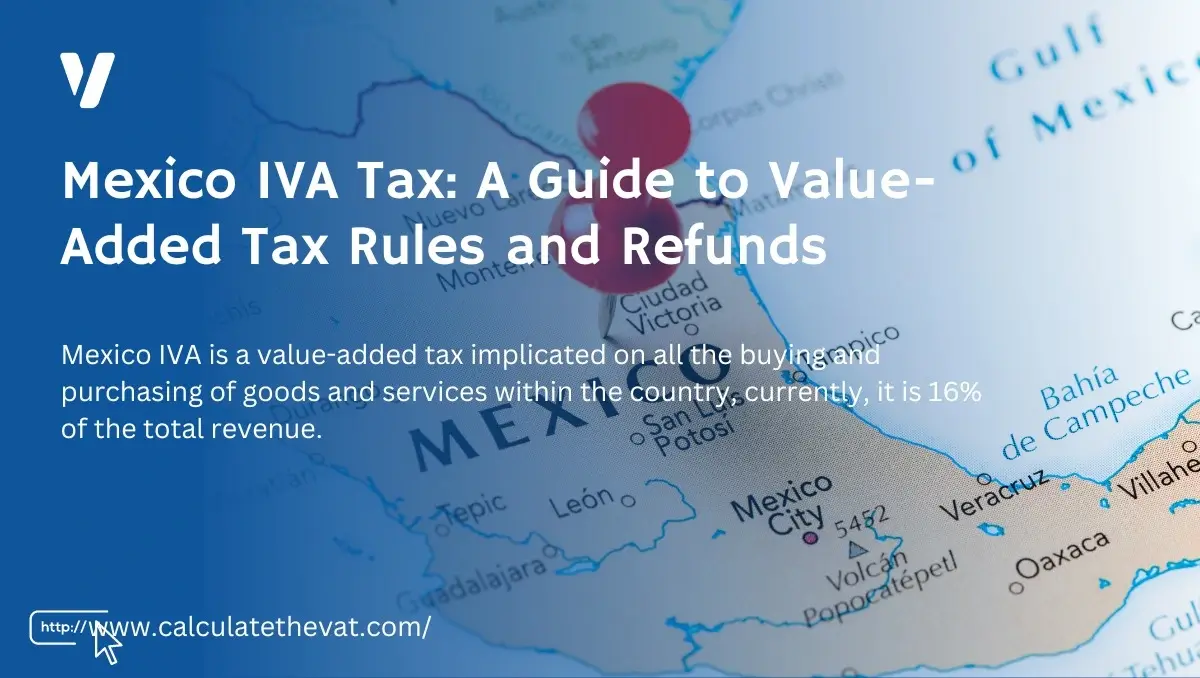

Mexico's Value Added Tax locally known as Impuesto al Valor Agregado (IVA), has been a key part of the country's tax system since its introduction in 1980. It is applied to the sale of products, provision of services, and importation of goods into Mexico.
Understanding the insights of VAT as a business owner, an entrepreneur, or a consumer is beneficial. You must know how to claim refunds and negotiate costs. To help you with it we prepared this guide which provides a clear understanding of Mexico's IVA Tax system. Stay by my side to check all the ins and outs of this tax.
If you are residing anywhere in Mexico then Value Added Tax will be levied on the consumption of goods and services. Usually, you need to pay the extra 16% of VAT which is set as the standard rate. You must be curious why a large portion of revenue is being levied, well it is crucial for public services and infrastructure. However, certain goods and services may qualify for a reduced rate of 8%, a 0% rate, or be completely exempt from IVA.
IVA Mexico is an indirect tax that is charged on products at the point of purchase and consumption rather than directly on income or wealth. This is important to ensure universal contribution to the tax burden regardless of financial standing.
This collection mechanism operates through a chain transfer system where businesses at each stage of production and distribution collect the tax. It is then passed sequentially until it reaches the end consumer, who ultimately bears the entirety of the tax burden.
Below we have provided details of the standard and reduced IVA rates, along with a comparison of past rates so you can understand better how these rates have evolved over time.
A reduced IVA rate of 8% is applied in specific border regions, including certain areas near the northern and southern borders of Mexico. Some points have a lower tax to help them grow better like food and medicine don’t have this tax.
| Rate | Type | Which goods or services |
|---|---|---|
| 16% | Standard | All other taxable goods and services |
| 8% | Reduced | VAT at Southern and Northern border regions. |
| 0% | Zero | Exports; certain basic foodstuffs (e.g., milk, wheat, meat, corn); medicine; some agricultural services. |
Over the years, Mexico's IVA rates have experienced several changes. Here’s a brief look at how these rates have evolved:
| 1980s | IVA was introduced in 1980 with a standard rate of 10%. |
| 1990s | The standard rate was increased to 15% in 1991 to boost government revenues. |
| 2000s | There were minor adjustments and the introduction of reduced rates for border regions. |
| 2010s | In 2010, the standard rate was increased to 16%, where it remains today. |
| 2020s | The current structure maintains the 16% standard rate, with an 8% reduced rate in designated border regions. |
Mexico’s VAT tax is added to the price when you buy something. The seller collects this tax and then pays it to the government. This happens at each step of making and selling a product. When a product is made, the maker adds a bit of tax to its price. Then, the store adds more tax when they sell it. In the end, you pay the full tax when you buy it. This way, the tax is spread out and not just on one person.
Example of how IVA Tax Mexico is Applied:
To understand how IVA is applied, let's look at a simplified example:
In Mexico, you can get back some of the VAT tax you paid. This is called a VAT refund. It is important to manage the finances effectively and ensure compliance with tax regulations
If you fulfil above mentioned criteria then file your IVA returns monthly, reporting both the IVA collected on sales and the IVA paid on purchases. If your purchases had more IVA than your sales, you can request a refund for the difference from the Servicio de Administración Tributaria (SAT) using their online system. Refunds typically take 30-60 days to process.
Mexico applies special VAT rates in its border regions to expand economic growth and competitiveness. This section discusses the unique tax rates and regulations for both the Northern and Southern border areas.
In the Northern Border Region, which includes cities such as Tijuana, Mexicali, and Ciudad Juárez, the IVA rate is reduced to 8% from the standard 16%. This reduced rate has an aim to uplift the local economies and make the region more competitive compared to neighboring countries, particularly the United States.
The Southern Border Region, which includes areas like Tapachula and Chetumal, also benefits from a reduced IVA rate of 8%. This initiative strives to support economic development and stability in the southernmost parts of Mexico.
Wrapping Up
Mexico IVA is currently set at a standard rate of 16%. Businesses in specific border regions benefit from a reduced rate of 8%. There is also a refund process to reclaim IVA on eligible purchases which is important to understand for better financial management. So follow up the rules and step towards scaling your business.
Do I need to register for Mexican VAT?
Yes, if you do business in Mexico, you need to register for VAT.
Can I issue Mexican VAT invoices electronically?
Yes, electronic invoicing (CFDI) is mandatory in Mexico.
What is the current IVA in Mexico?
The current standard IVA rate in Mexico is 16%.
Is IVA the same as VAT?
Yes, IVA is the Spanish term for VAT.
What is IVA on the Mexican bill?
IVA on a Mexican bill is the tax added to the sale of goods and services.
I'm a VAT professional with years of experience helping businesses with compliance and reporting. My goal is to simplify VAT calculation and provide valuable insights through my engaging writing style and clear explanations of complex concepts.